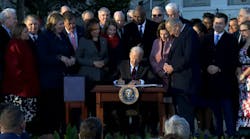USDOT’s Allies in Action reaches 100 members
The U.S. Department of Transportation (USDOT) received 25 new commitments from organizations and businesses that are supporting USDOT’s National Roadway Safety Strategy (NRSS), bringing the total number of Allies in Action members to more than 100. The strategy aims to reverse the number of deaths and serious injuries on America’s roadways. According to USDOT, more than 40,000 people die on American roads each year.
There were also close to 800 applications for funding from USDOT’s new Safe Streets and Roads for All (SS4A) competitive grant program, which helps communities plan and construct safer streets. SS4A award announcements are expected later this year.
USDOT’s Allies in Action have committed to expanding the adoption of a Safe System Approach and a Zero Fatalities vision across the nation and transform how we as a nation think about road safety. Allies in Action spans multiple sectors and includes health and safety advocates, the private sector, municipal and law enforcement organizations and more.
New voluntary commitments from Allies in Action include:
- San Diego Association of Governments will develop the first Regional Vision Zero Action Plan for the San Diego region’s 19 jurisdictions, 17 federally recognized tribes and more than 3.3 million people (42 percent historically underserved) to define a High Injury Network and to highlight near-term, high impact strategies, including “quick build” infrastructure options, safety project selection and funding prioritization recommendations, innovative public outreach and an interactive safety-data dashboard to monitor progress of all three plans.
- Qualcomm will continue to develop the technologies in their Snapdragon Digital Chassis solution to help make travel safer and more convenient for road users, including advanced driver assistance systems that can sense their surroundings and cellular-vehicle-to-everything (C-V2X) technology. Qualcomm will support industry stakeholders with deployments, focusing on Day 1 use cases that will have an immediate safety impact. Qualcomm will also continue collaborating on solutions that increase awareness for vulnerable road users, helping to protect pedestrians, cyclists, road workers, school children and other people who share the road with vehicles. Lastly, Qualcomm will continue to provide engineering guidance to support interoperable C-V2X system development.
- Massachusetts Bay Transportation Authority (MBTA) will support safer people by conducting monthly Bus Accident Reduction Committee Meetings that review safety performance indicators and targets, investigate findings and develop corrective action plans and by continuing to expand training requirements. In 2023, MBTA will implement a Bus Operator Recertification Course that is required of all operators every 2 years. MBTA will support safer roads through their 2023 Bus Network Redesign proposal for bus services, which aims to create more equitable networks with improved service. Lastly, MBTA will support safer vehicles and safer speeds through the integration of new technology that provides Advanced Driver Alerts and technology that monitors driver behavior, speed and harsh breaking events.
- Together for Safer Roads (TSR) is dedicated to bringing the public and private sectors together in shared partnerships to create safer operators, systems and ultimately roads. In 2023, these efforts will include three key initiatives, including recruiting new fleets for TSR’s Focus on Fleet Safety - a workforce development program for small- to mid-sized fleets. TSR will also pilot their Truck of the Future initiative, developed to increase 360-degree driver visibility among fleet operators. Lastly, TSR will launch their Direct Vision Rating System in partnership with both public and private sector fleets, allowing fleet owners to understand the level of visibility their fleets have and empowering them to retrofit vehicles to improve visibility.
National Roadway Safety Strategy Call to Action Workshop
Last month, dozens of Allies in Action gathered at USDOT headquarters in Washington, D.C., for a first-ever workshop to share progress, review case studies of notable practices, encourage new commitments and make connections to meet common safety goals. Among the key areas of discussion include using data to identify opportunities to improve safety, empowering communities and cross-sector collaboration.
Background
USDOT launched the NRSS in 2022 in response to the crisis of roadway deaths in America, which had been steadily rising since 2010 before they surged in 2020. In a positive sign, the last four quarters have shown small decreases in traffic fatalities, according to preliminary data.
The NRSS outlines a concrete set of actions USDOT has committed to and adopts the five-pronged approach that includes:
- Safer people
- Safer vehicles
- Safer speeds
- Safer roads
- Better post-crash care
In the coming months, USDOT will announce the second round of grant awards from the new SS4A discretionary grant program, funded by the Infrastructure Investment and Jobs Act. The competitive grants will help cities, counties, Tribes and metropolitan planning organizations create safety plans, demonstrate effective strategies and construct safety projects that prevent deaths and serious injuries on our nation’s roadways, from putting in high-visibility crosswalks to redesigning intersections and much more. In the first round of funding, USDOT was able to award funding to 511 projects.



